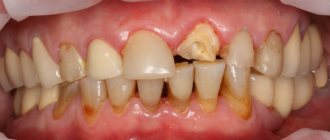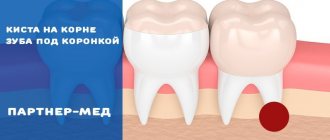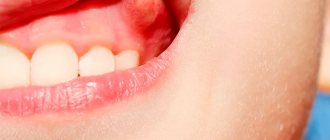Sign up for a consultation
+79252035555
Most often, people who feel a bad odor coming from their mouth seek advice from a dentist. Indeed, in 90% of cases of registered visits, examination reveals diseases of the teeth and gums that require treatment. After solving the problem, the bad smell stops bothering you. But sometimes patients who have crowns installed on their teeth begin to worry about the smell of rot coming from their mouth, and the source is clearly the tooth under the prosthesis.
Causes of odor under the crown
If the prosthesis is made and installed correctly, and the tooth is pre-treated or properly depulped, then no extraneous irritating odors will arise while wearing the crown - of course, with proper oral hygiene and regular dental examinations.
But it happens that either a crown is installed on an already defective tooth, or decay begins after the installation of the prosthesis for various reasons. Here the only possible way out is to eliminate the consequences by contacting the clinic.
The most common reasons why a prosthetic tooth begins to smell bad:
- Loose fit of the crown to the gum. If there is a gap between the edge of the denture and the mucous membrane, food particles will certainly get there. It is not possible to clean them with traditional means - a toothbrush and rinsing - so the substrate accumulates daily. Pathogenic bacteria begin to multiply on this biomass, rotting processes develop, and a specific smell appears.
- Depressurization of the connection between the crown and the tooth. This happens if the prosthesis is initially installed incorrectly or the cement is destroyed, and pathogenic microbes penetrate into the resulting cavities. As a result, inflammation of the gums occurs and even the development of secondary caries. All this contributes to the appearance of a characteristic unpleasant aroma from under the crown.
- Violation of the sealed connection with the tooth of the metal-ceramic crown . If, in addition, the crown is made on a metal base, if the cement layer is broken, air containing oxygen and saliva penetrate under the crown. In a humid environment, taking into account the pH of the salivary secretion, the metal of the crown undergoes oxidation, causing a bad odor. In addition, oxidized metal can become a source of irritation and allergic reactions of the gums.
- Lack of tooth protection after grinding. After preparing teeth for crowns, the final fixation of the crown does not occur immediately. Therefore, during the waiting period, the dentist puts a temporary prosthesis on the tooth stump or treats it with medical cement, excluding the penetration of bacteria into the tooth tissues that lack protection. If these steps are skipped for some reason, bacteria invariably settle in the tooth stump and cause decay under the permanent crown.
- Violation of the technology for manufacturing and installing the prosthesis. For various reasons (lack of proper equipment in the laboratory, low qualifications of the dental technician, little experience in prosthetics by the dentist, etc.), the crown is fixed on a tooth with irregularities. Gradually, injury to the tooth stump or soft tissue occurs with suppuration and the development of infection.
- Installing a crown on a tooth that required extraction . This doesn't happen very often. For example, it is necessary to install a bridge, and one of the supporting teeth must be removed. To save on implantation, the patient agrees to restore the defective tooth. As a result, after some time, the tooth is still destroyed, the tooth root is fractured, and the crown flies off. Therefore, if there is an indication for tooth extraction, then it should be removed and not used as a support for a crown.
- Lack of oral hygiene . Some dentures require careful care and cleaning of food debris. If simple steps are not taken, strains of pathogenic bacteria grow very quickly and putrefactive processes develop.
- Untreated caries and pulpitis at the stage of preparing the tooth for “crowning”. Hidden inside, diseases do not stop; on the contrary, they worsen. Therefore, it is first necessary to cure all dental caries.
- Poor quality depulpation. If the tooth canals are not completely filled, this causes the development of granuloma at the root apex. A granuloma, or cyst, is a cavity filled with pus. Also, the cause of the development of such inflammations is poor obturation of the root canals - with a loose arrangement of cement. Dr. Lopaeva’s clinic employs a professional dentist and endodontist who treats dental canals.
- Constant gum irritation. If the crown is poorly placed and regularly touches the gums, the mucous membrane responds with inflammation and swelling. The smell will also add severe pain. If there are no defects in the prosthesis, the doctor will trim the gum. If the defect is inherent in the product, you will have to install another crown.
Make an appointment with therapists at Dr. Lopaeva’s clinic
Make an appointment
Or call +7(985)532-21-01
How a crown is fixed to a tooth
Regardless of what material the crown is made of, it is always fixed in the same way - using dental cement. But first, the tooth to be restored must be prepared for prosthetics:
- remove caries-affected tissues
- carry out root canal treatment (if necessary)
- install a core pin (if the tooth is severely damaged)
- grind the coronal part (stump) and give it the correct shape
Form, by the way, is of great importance in this case. Firstly, the inside of the crown should copy the stump of the tooth. Secondly, its height and geometric shape directly affect the stability of the crown. Therefore, the result of prosthetics depends on both the orthopedist and the dental technician.
By the way, while he is working, you will be given a temporary crown. It is usually made of plastic. Of course, it stands out in the dentition, but it masks the absence of part of the tooth and protects it from damage. However, plastic is not the most reliable material, so during this period it is recommended to avoid foods that are too hard and viscous, so that the temporary crown does not fall out.
The crown is securely fixed to the tooth using dental cement. If the teamwork between the orthopedist and the dental technician was good, then the likelihood that the crown will fall out or break is very small
Symptoms of tooth decay under the crown
The first and very obvious sign of irreversible changes occurring in the tooth is not pain, as many expect, but the smell. Sometimes pain is not felt at all, because the standard preparation of a tooth for prosthetics includes depulpation - removal of the neurovascular bundle. Therefore, the tooth loses sensitivity.
You should pay attention to the following points:
- First, an unpleasant taste appears in the oral cavity, and then a foul odor, which is noticed even by others. The smell cannot be masked for long with mouthwash or chewing gum.
- Dietary fiber gets clogged under the crown of the tooth and has to be removed from there. But if some large particles of food can be removed from the gap between the gum and the crown, then a large mass of them remains inside and begins to decompose.
- Darkening of the tooth under the crown.
- When you feel the prosthesis with your tongue, you feel a depression, a hole where food gets in.
- The gums become inflamed near the restored tooth and soft tissue swelling develops.
- If the tooth stump under the crown is alive, then there is noticeable pain.
All of these circumstances require an immediate visit to the clinic for treatment and indicate tooth decay with the formation of pus. Delay in this situation will lead to serious health consequences and considerable costs for medications and therapy. If you do not take quick action, the pus, accumulating inside under pressure, will cause the formation of a purulent cyst at the apex of the tooth root. Or it will break into soft tissues, turning into gumboil. To eliminate the abscess, you will have to endure a surgical procedure to open the abscess.
In addition, you should not think that pus in a tooth is a local nuisance. Together with the bloodstream, the infection spreads throughout the body, having a detrimental effect on the heart, lungs, joints, etc. It is no coincidence that in every dental clinic there will certainly be a poster warning that a rotten tooth is a source of constant inflammation of the ENT organs, osteomyelitis, blepharitis and other unpleasant diseases.
A neglected tooth left to rot under a crown is sometimes completely destroyed and has to be removed. Thus, a person gets a hole in his mouth that will need to be closed with expensive restorations: an implant or the installation of a bridge.
What to do to get rid of the smell
When an unpleasant odor occurs in the mouth, a person most often realizes that the cause is tooth decay, but tries to deal with the problem on his own: rinses the mouth with various pharmaceutical products or infusions made according to folk recipes, tries to kill the bad odor with mouth odorants or chewing gum. If the tooth responds with pain, the person takes painkillers. As a result, tissue decay continues. Then the pain goes away - because the nerve endings die, and the patient believes that a cure has occurred.
The result is tooth loss. It is especially unpleasant if the crown covered a gap in the front row. Now the patient will have to install an implant and crown to maintain the aesthetics of the smile. Therefore, no matter how great the temptation is to let things slide or attempt to cure yourself, remember: dental diseases, especially tooth decay under the crown, cannot be cured at home. All of them require the intervention of a medical professional.
Before visiting the clinic, you can rinse your mouth with tinctures of herbs that have anti-inflammatory properties: a decoction of chamomile, oak bark, calendula. In the hospital, the dentist will determine the stage of tooth decay and perform a series of appropriate procedures. A sick but strong tooth is cured, a damaged one is removed. If there is no inflammation, and the cause of the smell is plaque accumulated in the space between the tooth and the crown, the doctor will clean the tooth of dirt. The crown is then subjected to additional processing to adjust the size and ensure a tight fit to the stump. After this, the prosthesis is fixed with sealing cement.
To ensure hygiene in the oral cavity, if there are one or more dentures, a good solution seems to be the purchase of an irrigator - a device that removes dirt and plaque with a disinfectant solution supplied under pressure. Even hard-to-reach areas that no toothbrush can reach can be cleaned.
Dentists also recommend using dental floss and rinsing your mouth with clean water every time after eating. Various agents with an antibacterial effect are used to rinse the mouth. They are not able to clean plaque from microscopic cracks and gaps between the prosthesis and the tooth stump, but they successfully destroy pathogenic microbes, stopping their life cycle.
If the destruction of cement, loosening of the crown or weakening of the pin occurs during the treatment guarantee, then all actions to restore the quality of the prosthesis are carried out free of charge. Therefore, it is important for the patient to monitor the crown and, if in doubt, contact the clinic where the restoration was made in time.
Install veneers without grinding Luxneers teeth at Dr. Lopaeva’s clinic
Find out more about Luxneers
Why is this happening?
So, what causes a denture or crown to fly off? In some cases, the cause may be external physical influences or other force majeure circumstances. However, most often the “dog is buried” in the poor quality of the dentist’s work.
Poor quality cementitious mixture . If its composition, quantity and application technology are violated, then over time the cement loses its properties, begins to crack and the crown falls out;
during the manufacture and installation of a prosthesis or crown were incorrectly calculated In other words, the shape of the supporting tooth and the internal plane of the artificial tooth do not coincide and the prosthesis begins to balance, destroying not only the cement fixation, but also the tooth itself.
What should a doctor take into account in order to properly install a crown or dental bridge? There are a number of points:
- features of bite;
- the extent of the defect, its configuration;
- correct treatment of teeth before installing a prosthesis;
- correctly calculated crown height and shape.
Treatment options for a tooth under a crown
When contacting the clinic, the dentist determines how great the changes are in the dental tissues, and based on the results of the examination, prescribes treatment.
- If the tooth stump has not undergone any changes and rot has not affected it, the doctor cleans out the accumulated food debris from under the crown. Then a new prosthesis or an old one, but corrected, is installed.
- If healthy roots remain, the crown is placed on the stump tab. This device is made in a dental laboratory from an impression and is a structure with peculiar “legs” that are designed to fix the inlay in the tooth canals. And a crown is attached on top.
- If both the upper and root parts of the tooth have rotted, the remains are removed from the mouth and periodontitis is treated. The patient then has to decide on how to restore the tooth. There are two options: implantation or installation of a bridge.
When contacting a clinic for initial prosthetics, it is important to find out at the stage of monitoring institutions whether the clinic provides a guarantee for the treatment provided. If there is a guarantee, then in case of medical errors, treatment and re-restoration are carried out free of charge for the patient.
Methods of fixing a crown to the root of a tooth
In dental practice, attaching a prosthesis to a destroyed stump is most often carried out using two methods. The first involves the use of a pin, the second - an inlay. Let's look at each of them in more detail.
Pins
A pin is a cheap way to restore. It is quite easy to install and is very reliable. Externally, it is a rigid rod that is placed in the root hole after filling is completed. It is held in it by a special cementing composition.
An intracanal post requires that the tooth base be healthy and of sufficient size. An obstacle to its installation may be a single canal that is too small, or a tooth with several thin or twisted roots. It is also forbidden to use it in case of serious pathologies of the blood and nerves, advanced periodontal diseases, or the presence of a cystic formation in the upper part.
Its characteristics and properties directly depend on the material from which the structure is made. This means: durability, service life, risk of an allergic reaction, biological compatibility with the tissues of the human body, etc. Allergic patients are usually recommended to install a titanium or zirconium rod. If the unit to be restored is located in the area of the mouth that bears the maximum chewing load, flexible carbon fiber products are preferred.
Metal rods are also considered durable. Due to their excellent performance characteristics and low cost, they are most often used in the restoration of chewing units. It is better not to restore incisors with their help - the metal will be visible through a thin layer of prosthetic coating.
Tabs
A stump inlay is a tooth stump cast with the root part. It is installed after filling. As with the post, the dentist prepares a small hole into which the support will be placed.
The inlay is made according to an individual layout. Visually, it resembles a natural ground stump. During its fixation, cement is used, which eliminates the appearance of cracks and ensures maximum tightness.
Inlays are either cast or collapsible. The latter are used if there are several canals in the tooth. Then a number of components are made removable so that they fit into the channels better and more reliably. If the collapsible inlay is made according to all the rules, it fits the tooth perfectly and extends the life of the preserved roots for decades.
Cast construction is most often used when there is only one channel. Then, with its help, you can easily achieve a uniform distribution of the chewing load. It is manufactured under high pressure and temperature, and is cheaper than a collapsible one.
As for materials of execution, ceramics, metal, zirconium, and precious metals are used in the production of stump structures. Ceramics are ideal if you need to bring incisors and fangs back to life - it does not lead to darkening of the gingival margin and does not show through the thin walls of the prosthesis. Due to this, the smile after completion of orthopedic treatment looks perfect.
It is believed that dentures installed using inlays are more reliable than those held in place by pins.
How to care for a crown
Both the dentist and the patient are interested in the crown serving its intended purpose for a long time. To increase the period of good functioning of the prosthesis, a person will need additional care products, because a standard toothbrush is not able to clean the removable element:
- The beam brush is designed to clean the internal surfaces of the prosthesis;
- The interproximal brush on the head contains a special brush that easily reaches hard-to-reach places on the lateral surfaces of the prosthesis, cleans the areas between the crown and adjacent teeth;
- Floss is required for regular cleaning of interdental crevices;
- If the household has an irrigator, it will be a constantly in demand device, because only it can clean the areas in the cervical fastenings of crowns.
What to do if the tooth under the crown has completely rotted
It happens that a tooth rots because the crown was initially installed on a defective stump. And sometimes the person himself is to blame for this development of events, because he delayed contacting the doctor.
If the tooth has at least its roots preserved, it is possible to restore the tooth with a special device - a stump insert. The structure is made of ceramic or metal and has branches according to the number of roots. These processes are fixed in the root canals to a third of their depth. The top of the stump tab is intended to strengthen the crown on it.
Often gold or silver is used to cast the stump insert. The first material is preferable because it shines through the crown with a warm yellow color. This shade is similar to the color of natural enamel and is not perceived as foreign. The silver tab has antibacterial properties, but the cold shade affects the visual pigmentation of the gums. This will bother the patient, especially if the tooth is located in the front.
If the roots are rotten, the stump insert will not hold in them. The remaining tooth is removed and restored with an implant or prosthetics.
If the adjacent teeth, which will play the role of supporting teeth, are preserved, it is possible to install a fixed bridge prosthesis. Removable dentures are also common: nylon, acrylic. Here you will have to focus on the amount that the patient is able to pay for this or that method of dental restoration, and the aesthetics that he prefers. During the consultation, the doctor will offer to look at the options for finished products in the photo, and the person will choose the appropriate type of product.
Types of crowns
Metal-ceramic crowns differ in the metal alloy from which the frame is made, the manufacturing method, and service life. In most cases, an alloy of base metals (chromium-nickel, chromium-cobalt) is used to make the frame. They are durable, reliable, and not subject to deformation. This is a budget option that, with proper care, will last 8-10 years.
Often the frame is made of an alloy of gold with palladium, platinum, and silver. These are hypoallergenic materials that have an antibacterial effect, containing up to 80-90% gold. Ceramic-lined structures look natural, so they are perfect for installation in the smile area. Service life – up to 12-15 years.
When it comes to prosthetics on implants, the base of the crown is made of titanium. The material is compatible with body tissues, does not cause allergies, and eliminates the development of galvanic effect (galvanosis). Such structures will last 15 years or more.
According to manufacturing technology, metal-ceramic crowns can be cast or milled. Ceramic mass is applied layer by layer to the finished frame, made by any method, firing each subsequent layer. Modern dentistry has solved the problem of the “blue” strip around the gums, which made the installation of metal-ceramic structures on the front teeth undesirable. Today, crowns with shoulder mass are used - the manufacturing technology provides for a special ledge, which is also lined with ceramics to avoid oxidation of the metal upon contact with the gum. This makes the prosthesis aesthetic, allowing you to restore incisors and canines.
What to do if a crown falls out
The crown sometimes flies off the tooth not only due to the complete destruction of the stump tissue. Sometimes the prosthesis comes off because it is poorly fixed to the cement: the material has collapsed or the adhesion to the crown material has been lost.
Often people do not attach importance to this, installing the crown in place on their own each time. However, such neglect is fraught with rotting of the tooth under the crown or accidental swallowing of the prosthesis. Therefore, you definitely need to contact the clinic to correct fixation deficiencies.
If the crown falls out along with the pin or stump, the conclusion is clear - the doctor did not properly strengthen the structure inside the tooth. Particular care must be taken to follow the technology when working with a stump insert: after it is placed in the root canals of the tooth, adjustment of the structure with a drill is possible only after 24 hours. This time is necessary for the cement to harden.
Inexperienced dentists often begin adjusting the inlay 10-15 minutes after installation. The cement breaks down before it has time to harden. Of course, soon the entire structure falls out into the oral cavity. If the crown is in satisfactory shape, a professional dentist can quickly return it to its place if you contact him without delay.
How an orthopedist can help
- The crown fell out, but the tooth remained in place.
The orthopedist can install the fallen prosthesis back if the tooth is not damaged and the integrity of the crown is preserved. - The crown fell out with the pin.
The doctor conducts diagnostics to assess the condition of the tooth root. If he is not damaged, he will install a new pin. Otherwise, the root will have to be removed. - The tooth fell out with its crown.
For recovery, the orthopedist will suggest implantation, installation of a bridge or removable prosthesis.
Causes of blood taste in mouth
Sometimes, in addition to the unpleasant smell, the patient is also bothered by the taste of blood in the mouth. Possible reasons for such sensations:
- Gingivitis develops, inflammation of the gums around the crown. The mucous membrane can become inflamed for various reasons. For example, the prosthesis fits tightly to the soft tissues, constantly rubbing them.
- The crown scratches and injures the adjacent gum. Blood is released, infection enters the wound, the mucous membrane becomes inflamed and bleeds. This only happens if the crown is not fixed correctly or if its dimensions are violated. Needs a complete refurbishment.
- Bleeding can cause unsatisfactory treatment of the tooth before placing a prosthesis. Poor filling of canals or incomplete removal of the pulp invariably causes inflammation and accumulation of purulent masses. Tissues are destroyed with the release of blood.
The appearance of blood discharge in the oral cavity should not be ignored. Pathogens easily penetrate an open wound, causing great damage to human health.
Preventive crown care
In order not to provoke the accumulation of masses under the crown and cause tooth decay, it is necessary to maintain oral hygiene. A crown is an artificial structure and will require more care.
- Brush your teeth twice a day, including using special brushes for caring for dentures.
- Rinse your mouth after every meal.
- Floss regularly.
- Use toothpicks only when necessary. This is not at all a means of maintaining dental hygiene! Picking with a wooden stick, expanding cavities in teeth and crowns, is contraindicated.
If you have already had the sad experience of tooth decay under a denture, pay more attention to the alarm bells: pain under the crown, bad smell, taste of blood in your mouth. Make an appointment with a dentist; timely treatment will be shorter and cheaper than treatment for a neglected tooth.
If you realize that the tooth has begun to rot, remember that the process is irreversible. It will not be possible to cure inflammation with home methods. You should not wait until there is severe pain or the crown falls out in your sleep, with the risk of suffocation. A diagnosis from a doctor will help you cope with the problem.
Make an appointment at Dr. Lopaeva's clinic
Make an appointment
Or call +7(985)532-21-01










